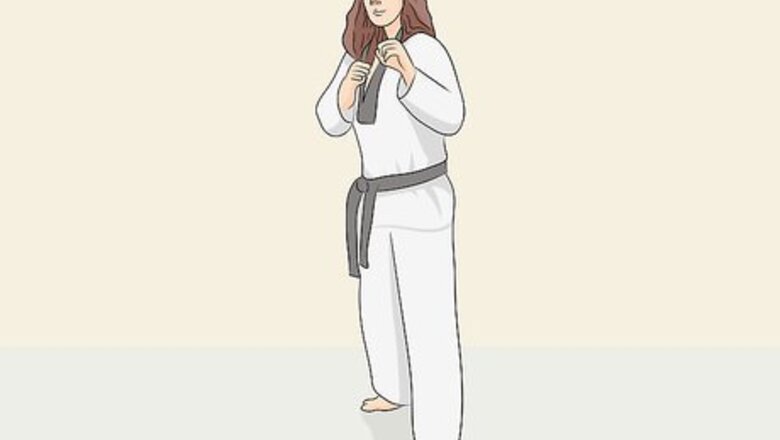
views
Performing Different Kicks
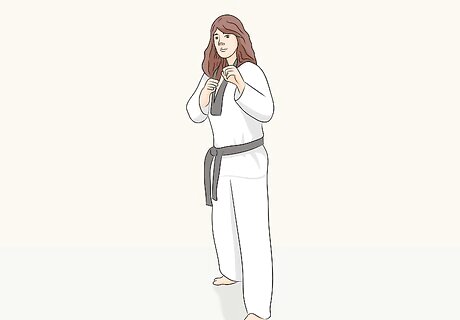
Begin all kicks in your fighting stance. The fighting stance is designed for good balance and you can perform almost any martial arts move from this basic position. Place your feet about shoulder-width apart. Then step forward with your weaker foot so it’s ahead of your dominant foot. Bring your hands up to the height of your chin. Stay light on your feet in your fighting stance, and practice shifting your weight from foot to foot. When you kick, you’ll be shifting your weight quickly, so being stiff will give you slow, weak kicks.
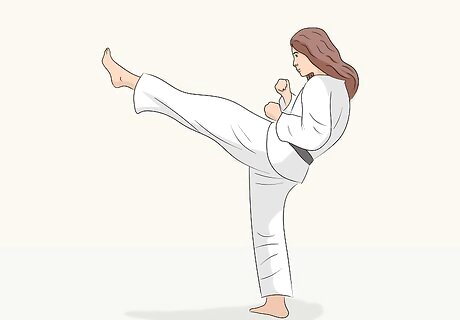
Snap your foot straight out for a front kick. A front kick is the most basic martial arts kick, but this doesn’t mean it isn’t powerful. Bring your back knee up towards your shoulder to enter the chamber position. Then extend your leg straight out for a strong kick. Curl your toes up and make contact with the ball of your foot. Focus front kicks at your opponent's midsection and torso. You could aim for the head if you can kick high enough, but most competitions ban head kicks. Never make contact with your toes or you could break bones in your foot. For a less powerful but faster attack, try performing this kick with your front leg instead of your back leg. It could catch your opponent off guard.
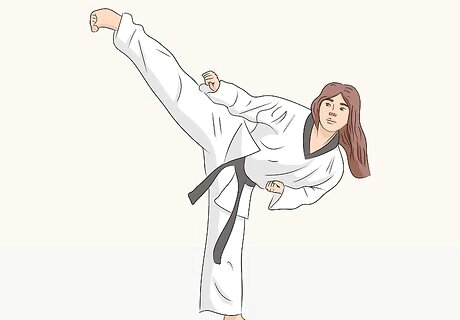
Throw a side kick for extra power. Side kicks, despite their name, are similar to front kicks because they both focus the energy straight in front of you. A side kick has more power behind it. Bring your back leg into a chamber position by pulling it up towards your opposite shoulder. At the same time, pivot your support foot so your toes point backward. Then extend your leg straight out for the kick. Make contact with the blade of your foot. If you throw the kick with your right leg, extend your left arm behind you at the same time. Do the opposite if you kick with your left foot. This helps maintain your balance. Like with front kicks, aim side kicks at the opponent's midsection. Side kicks are also a good kick to break boards with because they have a lot of power.
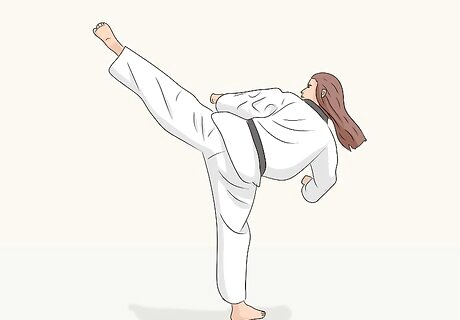
Attack from the side with a roundhouse kick. Unlike front or side kicks, a roundhouse kick focuses the energy sideways instead of straight in front. Enter a chamber position by raising your kicking leg and angling your knee in the direction you’re kicking. Shift the weight to your support foot at the same time. Throw the kick by extending your leg so it sweeps from one side to the other. Make contact with your lower shin, just above the ankle. Extend the arm on your kicking side down as you kick to maintain balance. While movies show martial artists roundhouse kicking opponents in the head, this is very difficult to do. It's also dangerous because you could tear a muscle or your opponent could catch your leg. Instead, aim for your opponent's thighs. Low kicks are harder to defend against and can do a lot of damage. Never make contact with the top of your foot when doing a roundhouse kick. The small bones here can break easily if you hit something hard.
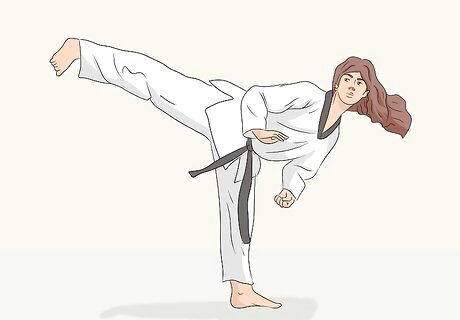
Strike with your heel when performing a back kick. A back kick is useful if someone tries to attack you from behind. Stand with your back facing your target. Bring your knee up to your opposite shoulder to prepare for the kick. Then throw your leg behind you with force. Make contact with your heel for the most power. Look behind you when you throw this kick so you can aim it better. Aim for the opponent's midsection. Like with a side kick, extend your arm on the opposite side to stay balanced. For a more complicated move, spin before throwing this kick to execute a spinning back kick.
Maintaining Your Balance
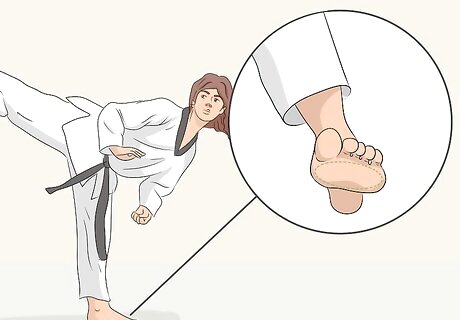
Keep your weight on the ball of your supporting foot. Any good kick needs a solid foundation. Whenever you perform a kick, shift your weight to the ball of your supporting foot as soon as you start raising your kicking foot. Shifting your weight around and staying balanced is much easier with the weight on the ball of your foot. Your heel doesn’t have to be off the ground for all kicks, but make sure the majority of your weight isn’t focused on this point. You’ll be stiff and less balanced with all your weight on your heel. Different kicks require your supporting foot to be in different positions. In a side kick, for example, your supporting foot faces backward. But no matter what the foot position is, always focus your weight on the ball of your foot.
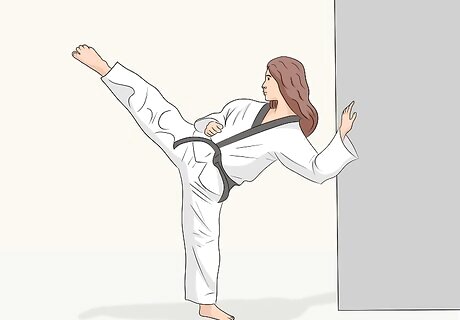
Lean your hand on a wall while you kick if you have trouble balancing. If you’re just starting out and have trouble balancing while you kick, work on the kicking motions while leaning on a wall. Stand beside a wall with your kicking leg further from the wall. Press your hand against the wall. Then bring your leg up to the chamber position and kick. Go through multiple kicks in this position, then switch to the other side. A chamber is the position you enter to prepare for a kick. The position changes depending on which kick you're throwing. If you’re going to kick with your right leg, stand with your left side closer to the wall. Press your left hand against the wall and kick with your right leg. Do these motions slowly so your body gets used to kicking. Touch the wall as lightly as possible. Just use it to help maintain balance. Don’t lean all your weight against it because then you won’t learn how to kick properly.
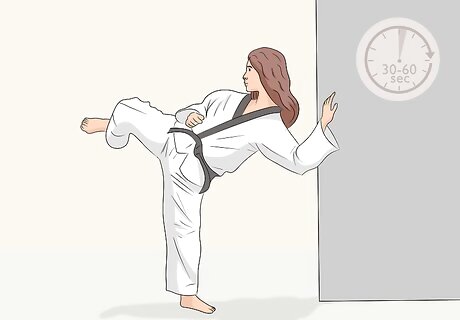
Hold yourself in the kick chamber position for 30-60 seconds. Once you can balance well enough to stop leaning on the wall while you kick, train your balance further by balancing in different chamber positions. Go through the chambers for different kicks and hold them as long as you can. Aim for 30-60 seconds each. This exercise strengthens your leg and back muscles and improves your balances over time. Different kicks have different chamber positions. For a front kick, bring your leg straight up with your knee bent. For a side kick, lift your leg to the opposite shoulder from your kicking leg with your knee bent. For a roundhouse kick, turn your body to the side and lift your leg forward, keeping your knee bent. Go through these motions to improve your balance. Add the chamber positions for different kicks if you know them. If you have trouble balancing in the beginning, try adding a few short hops to maintain your balance. As you improve, you’ll be more stable when your leg is in the air.
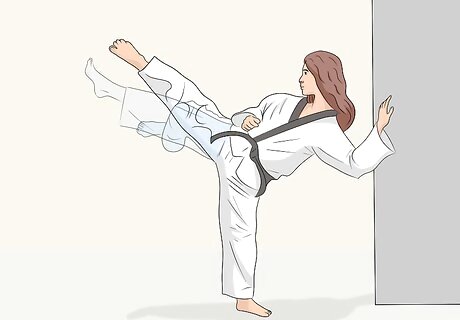
Switch to different chamber positions without dropping your foot. For a more advanced balance exercise, shift into different chamber positions without dropping your foot. A logical pattern is front kick, roundhouse kick, and side kick, but switch them in whichever order you find most comfortable. Shift the direction and weight distribution on your support foot as you change positions and keep your support leg straight.
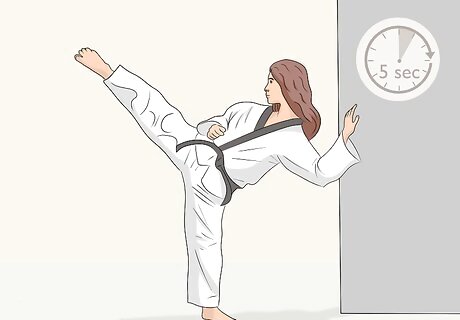
Extend your kicks and hold for them 5 seconds. When you’re comfortable holding the kick chamber positions, then add the kicks to this exercise. Bring your leg up into the chamber position and extend your leg to kick. Hold the kick fully extended for 5 seconds. Then retract your leg and lower it back into your fighting stance. Repeat this motion for all the kicks you know. Remember to train both legs as well. Don’t just drop your leg after you complete the kick. This is an incomplete motion and won’t train your balance. Slowly retract your leg and re-enter your fighting stance for a full motion. Even if this feels difficult at first, keep practicing. The more you improve your mechanics and balance, the less you'll have to think about it, which will allow you to focus more on power.
Building Power in Your Kicks
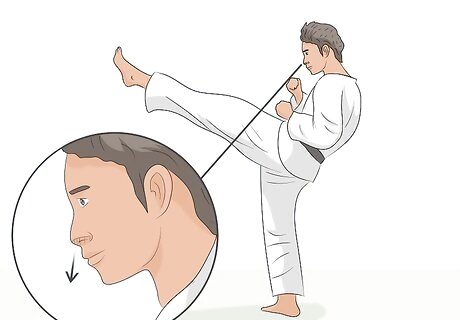
Exhale when you kick outward. If you hold your breath while kicking, your muscles will be tight. It’s much harder to coordinate your whole body’s strength if you’re stiff. Force a quick exhale whenever you kick to loosen up your muscles and put more power behind your kicks. Some martial arts use specific words for different moves. This forces you to exhale when performing attacks and represents a release of power.
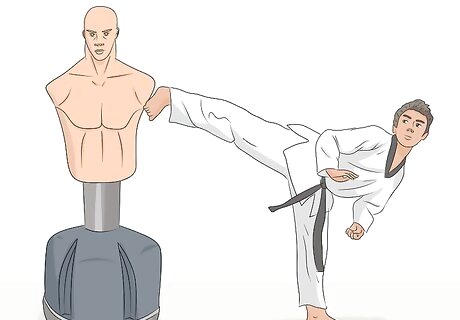
Snap your hip towards the target right before making contact. Use your whole body whenever you kick to add more power. When you kick outward from the chamber position, snap your hip towards the target. This directs your energy at the target so there is maximum force behind your kick when you make contact. Use the side of the hip that you're kicking from. If you're kicking with your right leg, snap the right side of your hip towards the target when you throw the kick. The hip snap goes in different directions depending on what type of kick you throw. In a front kick, for example, snap your hip straight forward. In a roundhouse kick, snap your hip sideways in the direction you’re kicking. Use your hips when you perform other attacks as well. A hip snap right before a punch adds a lot of power.
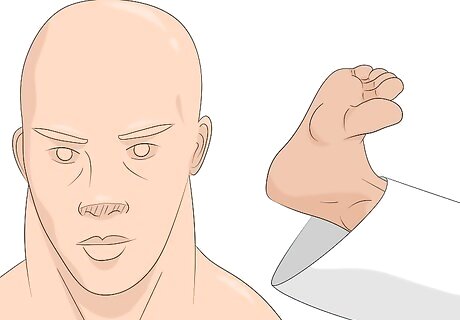
Avoid making contact with your toes or the top of your foot. While different kicks have different contact points, the toes or top of the foot are never the intended contact point. The intended contact point is usually a solid part of the foot that projects the most power and can withstand the impact. Kicking with the right contact point also prevents injuries by using the strongest parts of your foot. Learn the intended impact point of any kick you perform to maximize your power. Common impact points are the ball of the foot for a front kick, the blade of the foot for a side kick, and the shin just above the ankle for a roundhouse kick. Some other kicks up different parts of the foot. A hook kick, for example, uses the heel as its impact point.
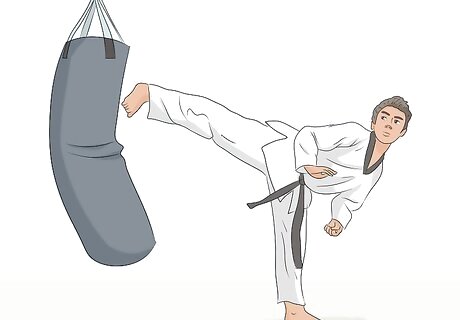
Practice with a heavy bag. Practicing in the air helps build balance, but you won’t build power unless you hit something. A heavy bag is a padded, yet solid, stand that you can perform different attacks on. Put all of your training together by hitting a heavy bag several times per week. First focus on doing the moves correctly. Then work up your power until you can hit the bag hard every time. See if a local gym has a heavy bag and train on it a few times per week. If no gyms have heavy bags, try to find a nearby martial arts dojo. If you want to hang a heavy bag at home, make sure you have a strong point that can withstand its weight. Mounted heavy bags are more convenient for home use. They are portable and have a base filled with water or sand.
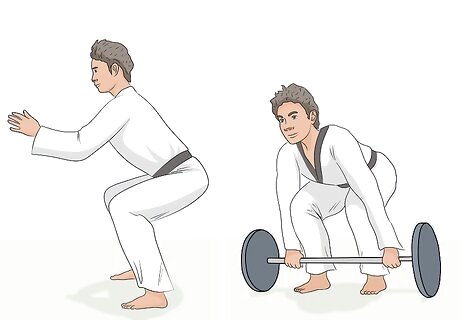
Strengthen your muscles with leg exercises. Doing exercises that strengthen your leg muscles will give you more powerful kicks. Design a workout regimen that targets your quads, calves, back, and core. These muscles all work together when you kick. Squats and deadlifts are compound, full-body exercises that especially target your legs and back. Short-distance sprints and deep squats will help you build leg strength, especially if you work out with a weighted vest. Plyometric exercises like box jumps, burpees, vertical jumps train your legs for the explosive power of kicking.














Comments
0 comment